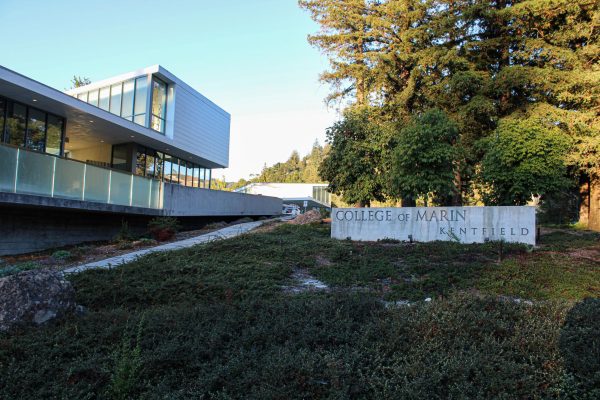With the spring semester in full swing, a wave of anticipation and stress sweeps through high school corridors, as seniors finalize their college applications. While envisioning future schools to attend, students must balance their personal goals and financial circumstances to find a path that can fulfill their preferences.

However, these decisions are often influenced by outdated norms, parental expectations and socioeconomic stigmas that exist in Marin. Thus, many students are left blind to the alternate paths that can be taken after leaving the walls of Redwood—specifically, the route of community college.
Caitlin Beard, a 2023 graduate of Redwood High School and current student at College of Marin (COM) decided to enroll at COM at the end of her senior year, despite skepticism from her community.
“I wanted to be able to go to a school where I wasn’t spending a ton of money and had the freedom to figure out what I wanted to study,” Beard said.
Despite facing controversy from her peers due to her choice, Beard asserts that this decision has been valuable. Upon entering COM, she reflected on her initial beliefs about going into a community college from her first weeks.
“There were all these preconceived notions… that Redwood students had taught me [about COM]…because of what their parents [or] college counselors told them,” Beard said.
Marin is ranked the fourth wealthiest county in the country according to SmartAsset, a financial technology company. This could potentially correlate with the prejudgment that students similar to Beard face, thus impacting students’ decisions to enroll in community college.
Similarly, Chelsea Lund, a graduate of The Branson School, initially attended Northeastern University before transferring to Santa Rosa Junior College after a year. Facing parental pressures, Lund struggled to determine her post-high school plans and was disinclined to deviate from her parent’s view of a conventional four-year college path.
“Our generation of parents came from a more traditional background, and [views] hadn’t really shifted for college yet,” Lund said. “[My parents] couldn’t quite understand why [I] wouldn’t want to do the same thing [as them].”
Having graduated from a competitive private high school, Lund encountered the strong emphasis on academic pressures that many students face in Marin.
“In Marin, being an affluent area, [there is] this assumption that you are going to go to an Ivy League or even just a four-year [college],” Lund said.
The reputations of private colleges, specifically Ivy League colleges, have potentially fostered a culture of hierarchy in which community colleges have been relegated to the sidelines or labeled as “the last resort.”
In the same way, Beard also acknowledged that financial circumstances often play a role in the perception of community college, as a family’s socioeconomic status influences the choices that students make concerning higher education. She saw this often in her high school experience.
“[Many students at Redwood] don’t even consider COM because they can afford to go to a four-year [college]. Why would they consider COM when they have the money to basically buy a more prestigious title at a school?” Beard said.
At Redwood, nine percent of students attend two-year institutions such as COM– a stark contrast to the 38 percent of students at San Marin High School, the highest percentage among Marin County public schools. This is according to data collected from the following high school demographic reports: Redwood, Tam, Archie Williams, Novato, Terra Linda, San Rafael and San Marin. This statement suggests that there is a difference in accessibility to four-year institutions among Marin residents.
Coming from a school with an 80 percent Advanced Placement (AP) participation rate, according to the Redwood demographic report, Beard reflects on the educational environment at Redwood. As an academically driven student, Beard did not conform to the stereotype of a two-year college attendee, an image held by many students in Marin.
“ [I] fit into this very specific mold of a very high-achieving student. I’d taken all the AP [courses] that the culture had [influenced] me to take, [and] I had stuffed my schedule with extracurriculars. I was on track to go to all these top, high-performing schools, and when I rejected all [of] that, everyone was kind of confused,” Beard said.
[I] fit into this very specific mold of a very high-achieving student. I’d taken all the AP [courses] that the culture had [influenced] me to take, [and] I had stuffed my schedule with extracurriculars. I was on track to go to all these top, high-performing schools, and when I rejected all [of] that, everyone was kind of confused,” Beard said.
Due to these fixed notions of attending a four-year college, many students who can afford “elite” universities are often unaware of the benefits a community college presents.
University of California (UC), Berkeley alumni Zoe Ives, attended COM during her first two years of college after graduating from San Marin. Ives has directly reflected on the benefits provided by a community college.
“When I transferred, I was terrified. I was like, ‘Okay, it’s probably been easy at COM. It’s going to be hard at Berkeley.’ But it was a smooth transition academically; COM really prepared me [for Berkeley],” Ives said.
Community colleges can offer numerous advantages at an affordable cost to students. This includes a wide range of associate degree programs, smaller class sizes and a flexible schedule, providing an effective and engaging learning environment.
“When I was at Berkeley, it was [around] 60 to 100 students in a class, so there’s not [much] personalized attention. Versus at COM, it was [about] 20 students [maximum], so I ended up getting close with a lot of my professors,” Ives said.
Furthermore, COM has established a strong partnership with four-year schools through the Transfer Admission Guarantee (TAG) program. This initiative ensures admission at all UC schools for all California Community Colleges students, excluding UC Los Angeles and UC Berkeley.
Becky Bjursten, the College and Career Center Specialist at Redwood, regularly informs students about the resources available at community colleges.
“There are also more benefits than just the [TAG] program, which is a great path to a UC school. You can save a lot of tuition by going to community college for one year and becoming a transfer student,” Bjursten said.
Additionally, Bjursten notes that COM recognizes that many students have full-time jobs, and allows students to accommodate their schedules to their needs.
“Some students choose to be full-time community college students, some choose to be part-time and work. You can live at home and not have a housing cost, or you can move away and still go to a community college and have that independent experience, [and] explore your education,” Bjursten said.
Despite the prevailing misconceptions associated with community colleges, when students begin to recognize the benefits provided, it may prove to be a viable option for their future endeavors, according to Beard.
“I feel like if people knew more about [community college], they wouldn’t look down upon it because they don’t understand how great the teachers are, how great the counseling services are and how smart all the students are,” Beard said.
This suggests that by changing the narrative about community colleges it must involve dispelling common misconceptions and alleviating the pressures of societal norms in Marin. In recognizing the benefits of community college, students can feel empowered to redefine their educational pathways.








